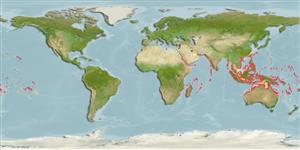Common names from other countries
Environment: milieu / climate zone / depth range / distribution range
Ecologia
Associadas(os) a recifes; não migratória (Ref. 348); estuarina; intervalo de profundidade 0 - 35 m (Ref. 348). Tropical; 23°C - 30°C (Ref. 102835); 28°N - 37°S, 31°E - 128°W
Indo-Pacific: Egypt to Pitcairn Islands and Ogasawara, Japan to Lord Howe Island.
Length at first maturity / Tamanho / Peso / Idade
Maturity: Lm ?, range 6 - 13 cm Max length : 41.7 cm SHL macho/indeterminado; (Ref. 117184); common length : 25.0 cm SHL macho/indeterminado; (Ref. 348)
The mantle color is highly variable, ranging from bright blue to brown.
Collected for food and for the shell trade. Aquaculture trials have been done in 1998 (Ref. 348). Maximum depth from Ref. 75831. Found in coral reef flats in shallow areas (Ref. 799), reef areas of lagoons (Ref. 97298) and in intertidal areas (Ref. 75831). Mixotrophic - filter feeds and photosynthesizes via its zooxanthellae (Ref. 105208). Tridacnids derive their nutrition from uptake of dissolved matter through their epidermis and from their symbiotic zooanthella Symbiodinium microadriaticum (Ref. 107098).
Life cycle and mating behavior
Maturidade | Reprodução | Desova | Ovos | Fecundidade | Larvas
Life cycle: Embryos develop into free-swimming trocophore larvae, succeeded by the bivalve veliger, resembling a miniature clam (Ref. 833).
SAUP Database. 2006. (Ref. 356)
Categoria na Lista Vermelha da IUCN (Ref. 130435)
Categoria CITES (Ref. 108899)
Not Evaluated
Ameaça para o homem
Reports of ciguatera poisoning (Ref. 130160)
Utilização humana
Pescarias: espécies comerciais
FAO - Aquacultura: produção; | FishSource | Sea Around Us
Ferramentas
Fontes da internet
Estimates based on models
Preferred temperature
(Ref.
115969): 24.8 - 29.3, mean 28.4 (based on 3421 cells).
Resiliência
Médio, tempo mínimo de duplicação da população 1,4 - 4,4 anos (K=0.18-0.28; tm=3.8).
Prior r = 0.49, 95% CL = 0.32 - 0.73, Based on 1 data-limited stock assessment.
Vulnerabilidade
Low vulnerability (25 of 100).
Categoria de preço
Unknown.
